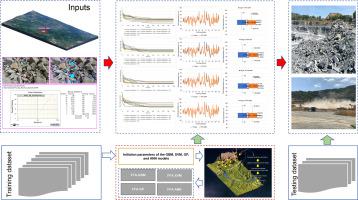Geoscience Frontiers ( IF 8.5 ) Pub Date : 2020-12-23 , DOI: 10.1016/j.gsf.2020.11.005 Chengyu Xie , Hoang Nguyen , Xuan-Nam Bui , Yosoon Choi , Jian Zhou , Thao Nguyen-Trang

|
Blasting is well-known as an effective method for fragmenting or moving rock in open-pit mines. To evaluate the quality of blasting, the size of rock distribution is used as a critical criterion in blasting operations. A high percentage of oversized rocks generated by blasting operations can lead to economic and environmental damage. Therefore, this study proposed four novel intelligent models to predict the size of rock distribution in mine blasting in order to optimize blasting parameters, as well as the efficiency of blasting operation in open mines. Accordingly, a nature-inspired algorithm (i.e., firefly algorithm – FFA) and different machine learning algorithms (i.e., gradient boosting machine (GBM), support vector machine (SVM), Gaussian process (GP), and artificial neural network (ANN)) were combined for this aim, abbreviated as FFA-GBM, FFA-SVM, FFA-GP, and FFA-ANN, respectively. Subsequently, predicted results from the abovementioned models were compared with each other using three statistical indicators (e.g., mean absolute error, root-mean-squared error, and correlation coefficient) and color intensity method. For developing and simulating the size of rock in blasting operations, 136 blasting events with their images were collected and analyzed by the Split-Desktop software. In which, 111 events were randomly selected for the development and optimization of the models. Subsequently, the remaining 25 blasting events were applied to confirm the accuracy of the proposed models. Herein, blast design parameters were regarded as input variables to predict the size of rock in blasting operations. Finally, the obtained results revealed that the FFA is a robust optimization algorithm for estimating rock fragmentation in bench blasting. Among the models developed in this study, FFA-GBM provided the highest accuracy in predicting the size of fragmented rocks. The other techniques (i.e., FFA-SVM, FFA-GP, and FFA-ANN) yielded lower computational stability and efficiency. Hence, the FFA-GBM model can be used as a powerful and precise soft computing tool that can be applied to practical engineering cases aiming to improve the quality of blasting and rock fragmentation.
中文翻译:

基于元启发式算法和机器学习算法的各种新型软计算模型预测爆破中的岩石尺寸分布
众所周知,爆破是一种在露天矿中破碎或移动岩石的有效方法。为了评估爆破质量,岩石分布的大小被用作爆破作业的关键标准。爆破作业产生的超大岩石中很大一部分会导致经济和环境破坏。因此,本研究提出了四个新颖的智能模型来预测矿山爆破中岩石的分布,以优化爆破参数以及露天矿中爆破作业的效率。因此,具有自然灵感的算法(即萤火虫算法– FFA)和不同的机器学习算法(例如,梯度提升机(GBM),支持向量机(SVM),高斯过程(GP)和人工神经网络(ANN) )组合在一起(简称为FFA-GBM),FFA-SVM,FFA-GP和FFA-ANN。随后,使用三个统计指标(例如,平均绝对误差,均方根误差和相关系数)和颜色强度方法,将上述模型的预测结果相互比较。为了开发和模拟爆破作业中岩石的大小,使用Split-Desktop软件收集了136个爆破事件及其图像,并进行了分析。其中,随机选择了111个事件用于模型的开发和优化。随后,其余25次爆破事件被应用以确认所提出模型的准确性。在本文中,爆破设计参数被视为预测爆破作业中岩石尺寸的输入变量。最后,所得结果表明,FFA是估算台式爆破中岩石碎裂的鲁棒优化算法。在这项研究中开发的模型中,FFA-GBM在预测碎石的大小方面提供了最高的准确性。其他技术(即FFA-SVM,FFA-GP和FFA-ANN)产生较低的计算稳定性和效率。因此,FFA-GBM模型可以用作功能强大且精确的软计算工具,可以应用于旨在提高爆破和碎石质量的实际工程案例中。











































 京公网安备 11010802027423号
京公网安备 11010802027423号